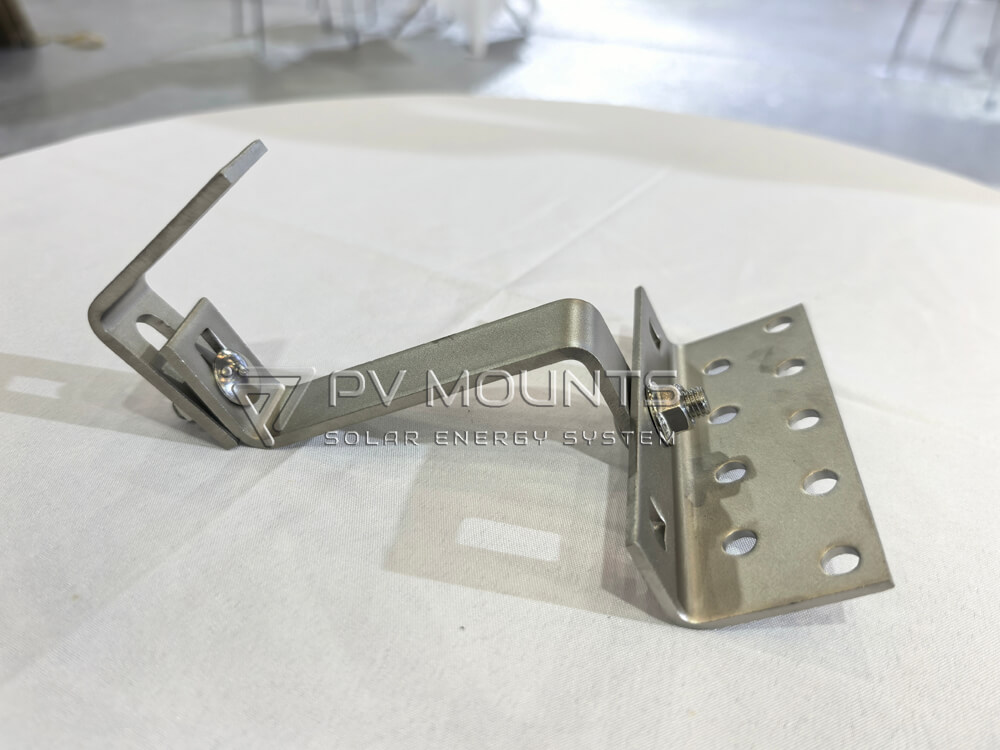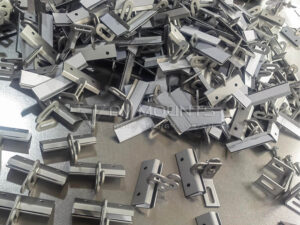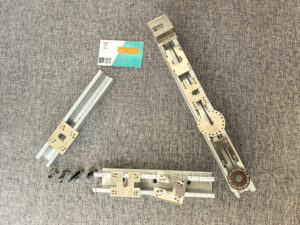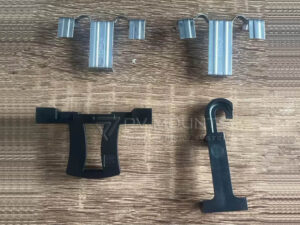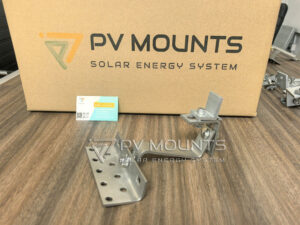جدول المحتويات
Introduction to SUS430 for Solar Tile Roof Hook
Solar mounting systems are only as strong as their smallest parts. Among these, roof hooks play a crucial role in keeping solar panels secure on tile rooftops. Choosing the right material for these hooks is vital because it determines safety, longevity, and cost-effectiveness. One material that has gained attention in the solar industry is SUS430 stainless steel.
SUS430 for solar tile roof hook applications is becoming popular due to its balance between performance and affordability. While other stainless steels like SUS304 are often the first choice, SUS430 provides unique advantages for certain environments and project budgets. This article dives deep into why SUS430 is considered suitable for roof hooks, exploring its properties, benefits, limitations, and real-world applications.
What is SUS430 Stainless Steel?
SUS430 belongs to the ferritic stainless steel family. Unlike austenitic steels such as SUS304, it has lower nickel content, making it more cost-effective. It contains about 16–18% chromium, which gives it corrosion resistance, and has good formability, making it easy to manufacture into solar roof hooks.
Key Properties of SUS430 Stainless Steel:
- مقاومة التآكل: Performs well in mild environments.
- Mechanical Strength: Provides strong structural support.
- Magnetic Properties: Unlike SUS304, SUS430 is magnetic.
- Cost Advantage: Lower production cost compared to nickel-rich grades.
Compared to SUS304, SUS430 does not perform as strongly in marine or highly corrosive environments. However, in inland or less aggressive climates, it offers adequate durability while keeping costs under control.
Why SUS430 is Used for Solar Tile Roof Hook
The choice of SUS430 for solar tile roof hook systems stems from a combination of practical and economic reasons. Manufacturers often use SUS430 because:
- It balances performance and cost. Projects with strict budgets can use SUS430 without sacrificing too much in durability.
- It provides sufficient corrosion resistance. For residential and commercial solar systems installed in moderate climates, it holds up well.
- It is easy to process and manufacture. Its formability allows for adjustable hook designs, a critical feature in solar mounting systems.
When combined with surface treatments like passivation or coatings, SUS430’s lifespan increases significantly, making it a smart option for many solar projects.
SUS430 for Solar Tile Roof Hook
Roof hooks made of SUS430 are designed to anchor solar panels securely to tiled roofs. These hooks must withstand heavy loads, strong winds, and thermal expansion. SUS430 for solar tile roof hook applications has proven to deliver reliable performance when properly designed and installed.
In real-world projects, SUS430 roof hooks have shown to maintain structural integrity over years of use. They are especially popular in residential solar installations where cost is an important factor.
Benefits of Using SUS430 in Roof Hooks
Using SUS430 brings several advantages to solar mounting systems:
- المتانة: Provides sufficient mechanical strength for standard rooftop installations.
- Weather Resistance: Performs well in non-marine climates with normal exposure to rain and sunlight.
- Affordability: Cuts down costs without significantly compromising performance.
- Structural Reliability: When engineered properly, SUS430 roof hooks can carry loads comparable to SUS304.
For solar contractors, this means being able to offer more competitive system pricing while still delivering safe, long-lasting solutions.
Challenges and Limitations of SUS430
Despite its strengths, SUS430 is not without challenges:
- Lower Corrosion Resistance: It may not be suitable for coastal or high-salt environments.
- Less Ductile than SUS304: Can be harder to work with under high stress conditions.
- Risk of Rusting Without Coating: Requires careful surface treatment to extend life span.
Understanding these limitations is critical when deciding whether to use SUS430 for your solar project.
Comparison of SUS430 vs SUS304 for Solar Roof Hooks
| Feature | SUS430 | SUS304 |
|---|---|---|
| مقاومة التآكل | Moderate | Excellent |
| Mechanical Strength | Good | Very Good |
| التكلفة | Lower | Higher |
| Durability in Coastal Areas | Limited | Strong |
| Magnetic Properties | Magnetic | Non-magnetic |
| Common Application | أسطح المباني السكنية | Large-scale, marine, or premium projects |
The table above highlights that while SUS304 offers superior protection and strength, SUS430 stands out for affordability.
Design Considerations for Solar Tile Roof Hooks
When using SUS430 for solar tile roof hook, design matters just as much as material. Important considerations include:
- Adjustability: Hooks should allow height adjustment to match uneven roof tiles.
- Load Distribution: Wider baseplates prevent tile breakage.
- Compatibility: Hooks must fit both flat and curved tiles.
Manufacturers often design SUS430 hooks with extra thickness to compensate for slightly lower strength compared to SUS304.
Manufacturing and Quality Standards
To ensure reliability, SUS430 hooks must comply with international standards like ISO 1461 (galvanization) and IEC guidelines for solar mounting. Surface treatments like electro-polishing or passivation enhance corrosion resistance.
Quality control often includes:
- Salt spray testing
- Load testing
- Coating inspections
These measures guarantee that SUS430 roof hooks perform as expected in real-world conditions.
Installation Tips for SUS430 Solar Tile Roof Hooks
Installing roof hooks requires precision. For SUS430 for solar tile roof hook, follow these best practices:
- Use stainless steel fasteners to avoid galvanic corrosion.
- Ensure hooks align perfectly with rafters for maximum strength.
- Avoid overtightening screws, which may damage tiles.
- Apply protective sealant around penetrations.
By following these steps, solar contractors can maximize the performance of SUS430 hooks.
الصيانة وطول العمر الافتراضي
Although stainless steel is low-maintenance, regular inspections are essential:
- Check for corrosion signs at least once a year.
- Clean with mild soap to remove dirt buildup.
- Replace damaged hooks promptly to prevent safety risks.
With proper care, SUS430 hooks can last 20+ years in suitable environments.
Sustainability and Environmental Impact
One of the biggest advantages of SUS430 is its recyclability. Unlike galvanized steel, stainless steel can be recycled without losing properties. Its lower nickel content also means less environmental burden during production.
For eco-conscious solar developers, this makes SUS430 an attractive option.
Cost Analysis and Return on Investment
Material cost can be a deciding factor in solar projects. SUS430 offers:
- Lower upfront cost compared to SUS304.
- Competitive lifespan when maintained correctly.
- Higher ROI for budget-focused residential projects.
By balancing performance and affordability, SUS430 delivers strong financial returns.
Case Studies and Industry Applications
- Residential Rooftops in Asia: Widely used due to cost sensitivity in emerging markets.
- Commercial Installations in Europe: Used in inland regions with mild climates.
- Solar Farms: Sometimes used for budget installations with additional coatings.
These examples show how versatile SUS430 roof hooks can be when applied correctly.
FAQs on SUS430 for Solar Tile Roof Hook
Is SUS430 strong enough for solar roof hooks?
Yes, when designed properly, it provides sufficient strength for most residential and commercial projects.
Can SUS430 be used in coastal areas?
Not recommended without special coatings, as high salt exposure accelerates corrosion.
How long do SUS430 roof hooks last?
With proper maintenance, they can last over 20 years in non-marine environments.
Why is SUS430 cheaper than SUS304?
It contains less nickel, making it more affordable to produce.
Do SUS430 roof hooks need extra protection?
In aggressive environments, additional coatings or surface treatments are advised.
Which is better: SUS430 or SUS304 for solar roof hooks?
SUS304 is superior for durability, but SUS430 provides better cost-performance balance in inland projects.
الخاتمة
Choosing the right stainless steel for roof hooks is a decision that affects safety, durability, and cost. SUS430 for solar tile roof hook applications is an excellent choice for many projects, especially where cost matters and environmental exposure is moderate. While SUS304 remains the premium option, SUS430 stands out as a practical, reliable, and sustainable material that helps make solar energy more affordable.
By understanding its strengths and limitations, solar contractors and project owners can make informed decisions that ensure long-term system performance.


